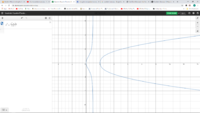James Ibarra
New member
- Joined
- Apr 22, 2020
- Messages
- 26
1. Analyze completely and graph the curve represented by the equation y2=(x2-2x)/(x-1)
Since i was hospitalized for almost 3 weeks, I missed most of the online lessons my class instructor gave from the past month. But i was still needed to pass something in order to pass the subject. I was given this problem but i missed most of the lessons and I really don't know how to tackle this. is this a bit close graphing linear equations like y = mx +b? or is it far from it?
Since i was hospitalized for almost 3 weeks, I missed most of the online lessons my class instructor gave from the past month. But i was still needed to pass something in order to pass the subject. I was given this problem but i missed most of the lessons and I really don't know how to tackle this. is this a bit close graphing linear equations like y = mx +b? or is it far from it?

